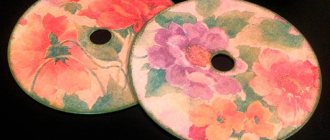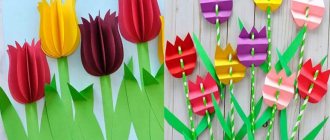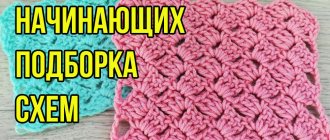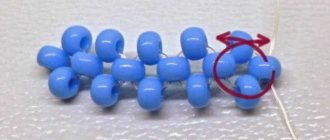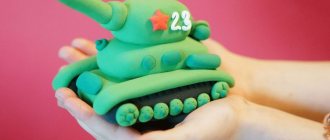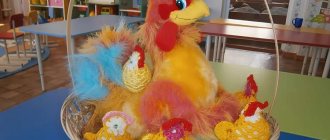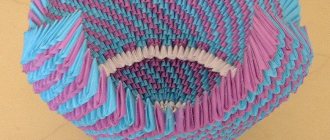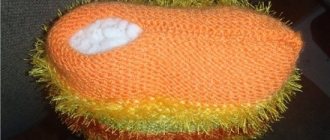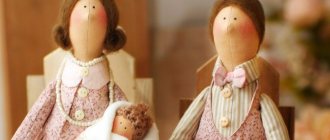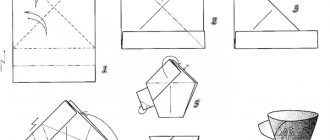We draw water lilies on the water step by step with paints on paper
This drawing will appeal not only to children, but also to adults. We will create a picture of water lilies.
We will paint with gouache. And the first thing you need to do is create a background by applying dark blue paint to the entire sheet of paper.
Then we take the green paint and apply it over the blue. But not with a second layer, but blurred in the lower and upper parts of the picture. The brush should be damp.
Similarly, rub white paint into the upper part of the drawing. Using a damp brush, blur it over the main background.
At the next stage you will need to draw the leaves of the water lilies. To do this, mix three colors: white, green and blue, and with the resulting shade we draw ovals, which will later become leaves.
Now mix white with green and yellow. Using this shade we draw contours along the edges of the leaves.
Mix white and dark blue. Similarly, add a few strokes to the leaves.
The final step is to add green on top of each leaf. but a little.
Then we mix blue with brown and outline each leaf with the resulting shade. At the same time, draw stripes on the water with the same color.
Now we mix the blue color with white and make highlights on the water. There are more of them in the lower part of the picture, and in the upper part there are smaller backgrounds.
The leaves are ready, now you need to draw the water lily flowers.
Drawing water lilies
Mix white with pink, add a little blue. Using the resulting shade we draw the petals of the water lily flower. Apply each petal with a separate stroke.
Then along the edge of each petal we make strokes of white to give the flower volume.
These were the petals that are visible from the inner upper side. Now we draw the outer petals. This is the second row. Add more pink to make the shade more saturated. Apply the next group of petals. After we have drawn these petals, we also draw white along their edges.
Add a little white to this color, which was used to paint the second row of petals. With this lighter shade we draw the third row of petals.
Mix pink, white and blue and draw the last row of petals. Add more blue and shade the edges of the petals.
Using the same color under the flower we draw a highlight or its reflection on the water. Then use blue to separate the flower from this highlight.
Draw an unopened bud next to it in light pink. Use brown paint to add a shadow to the leaves and blur it a little with a damp brush.
Using a light shade, add contours to several petals, stripes on the water, where the shadow of the flower is. These were the finishing touches. As a result, we got this wonderful picture.
What is gouache and its pros and cons
Gouache is a water-soluble adhesive-based paint with the addition of white. According to its properties, this paint is denser and more matte after drying, than, for example, acrylic or watercolor.
The technique of making gouache paints has been known since the Middle Ages, when it was used in Europe. The term itself originated in France in the 18th century (from the French Gouache - water paint).
Gouache paints are easily diluted with water and dry quickly. That is why they are preferred to be used in art classes at school and in the initial stages of learning to draw.
The paint has good hiding power and should be quite thick, so it is better not to work with this paint with glazes.
As I wrote above, gouache also contains white. This affects the color of the paint and the surface of the design after drying. The paint becomes more velvety to the touch, but the color also changes to a lighter color, different from what you see in the tube. Therefore, white should be used here with caution so as not to get too light a drawing.
How to draw a peacock step by step with a pencil
It turns out that drawing such a bird is easier than it seems. Even a small child can cope with this if he carefully follows the detailed master class. It is necessary to begin the creative process with the preparation of materials. It all depends on the preferences of the painter. It is better to draw the figure with a simple pencil. If suddenly something doesn’t work out, you can always erase it with an eraser. For coloring, you can take whatever you want - pencils, felt-tip pens, crayons, paints.
First step
Let's start by creating the body of the bird. It is small, in the shape of an irregular circle. Then we draw a line - the basis for the neck, and at the tip of it a small circle - the head. Next, we’ll draw the lower border of the bird’s loose tail and casually make two lines at the top - this is its upper border. Let's draw lines for the legs.
Second step
Around the circle we will draw a base for the bottom row of bright feathers. Then we draw the neck and one wing. Let's make the legs clear and draw segments for the second row of feathers. For now we are only making preparatory lines for the bird, so we shouldn’t push too hard with the pencil during the process.
Third step
Now we need to create the eye, beak and cute curls on the head. All that remains is to make lines for a new row of feathers, and you can move on.
Fourth step
In this step you need to draw a couple of small details: segments for the final row of feathers and a couple of curls near the body. The penultimate and last rows of feathers touch the lines that were drawn at the very first stage.
Fifth step
Now it's time to create individual feathers, which are also called "eyes". You can see how other artists or creative people portray it. Let's draw a straight line, then a circle, which will need to be “dressed” with small feathers. Draw a few curls inside the circle.
Sixth step
Remove the extra lines that were used to make it easier to draw and color the miracle bird!
Drawing a peacock step by step
If you can't figure out which shades to use, look at images online.
Another way to draw a peacock
How to draw a peacock with paints
If a child or a novice artist prefers to work with paints, then you can depict a peacock in color. The basis for the work is drawn with a simple pencil. In the process of creating lines, you should not put too much pressure on it so that the segments are not too thick.
In addition to simple tools, you will need paints, watercolor or gouache.
Step by step painting with paints
You will also need to prepare a jar of water, squirrel brushes, preferably thick and thin, a palette and paper for watercolors. Instructions on how to paint a magnificent bird look like this:
- We make two ovals - large and small. The first will be the body, and the second will be the head. We connect these circles with a smooth curved line - this is the neck. Let's draw a large straight line down from the body - it will set the direction of the tail. Below the body we will draw two nearby perpendicular straight lines - this will be a stand for the bird.
- We depict the neck, beak, curls on the head, paws and tail.
- Add eyes, feathers, eyes on the tail, draw a stand.
- Let's take blue paint and paint the body with it, darkening everything around the edges. We use brown and yellow shades for the feathers, and green for the tail. At the last stage, we finish the eyes using blue or dark blue color. Using white paint we create highlights on them. Let's color the paws, head, eyes, beak and stand.
- To draw a peacock for a child, it is worth using examples of ready-made drawings or sketches that can be used to repeat the outlines of the bird. This will simplify and speed up the process.
A selection of master classes on drawing a peacock:
Master class on complex drawing
An interesting effect is obtained if you draw on crumpled paper. The pigment fills the fractures, and the image resembles a marble pattern. This technique is used to paint a tropical landscape.
For art you will need:
- gouache;
- watercolor paper;
- a simple pencil;
- wide and thin brush;
- iron.
Technique:
- Crumple the sheet of paper well, and then smooth it out and straighten it with your hands;
- prepare a wide brush;
- Draw a horizon line using diluted blue;
- in the center above the horizon, draw a semicircle of the sun with translucent yellow gouache;
- half paint the sun;
- use a wet brush to blend the color towards the center;
- use an orange translucent color to outline the outline of the sun;
- blend with a damp brush onto the outside;
- paint the sky along the edges of the sheet with pink or purple, the paint is still well diluted to a watercolor state;
- blend again with a wet brush towards the center of the sheet;
- under the semicircle of the sun, place three strokes in the form of the corners of an inverted triangle and also blur them to create a reflection of the sun;
- on the sides, under the horizon line, place strokes of blue paint and blend them with yellow ones;
- use strokes and blur to paint over the lower part of the sheet, which depicts the ocean;
- wait until the painting dries;
- iron;
- dip a thin brush in black gouache and draw two lines from the lower left corner - future palm trees;
- draw them bolder and mark the trunks, and draw leaves on the tops;
- against the background of water, draw the contours of dolphins with a pencil and paint them with black;
- Along the edges of the picture, mark the contours of tropical leaves and also sketch in black.
The result will be an ocean sunset peeking through the jungle.
Application options
There are several ways to place paint on drawings:
- Continuous coating – smooth painting of a selected surface. Used to create backgrounds.
- Identification of main components. Similar to a continuous coating, but performed on a fragment with the designation of its boundaries and detailing.
- Emphasizing contours with a similar but slightly distinguishable tone.
- Ipasto is a fine painting of individual elements of 1 or several objects in the design.
- Transition from one tone to another (glaze). This option for applying paint is not suitable for all types of dyes: it is not used when working with dry and oil dyes.
Painting using the glaze technique.
Life hacks when working with gouache
Not all parents are happy when their kids express a desire to paint. This is easy to understand. Gouache spilled on a table or clothes can ruin the mood of a mother and a young artist for a long time. To prevent this from happening, it is enough to dilute the paint with water in advance to the desired consistency. The jars themselves can be glued to small plywood. Then they will not tip over and spill.
Often the child spoils the paints by mixing colors and not rinsing the brushes sufficiently. This will not happen if you give him different brushes for each color, marking them with markers. Then the child will no longer need water, which means he will not be able to spill it on the floor, table or clothes.
All these life hacks will help you avoid troubles while painting with paints.
Get creative
Characters
- Quickly sketch a portrait of Frankenstein.
- Choose and draw your favorite superhero.
- Transform your pet into a character.
- Draw a scene from your favorite fairy tale.
- Develop a high-tech robot or car from the future.
- Draw random doodles and then turn those doodles into a character.
- Create your own anime character.
Lettering and calligraphy
- Practice your calligraphy and lettering skills.
- Sketch your favorite quote.
- Turn a word or letter into a drawing.
- Create your own font.
- Create a logo for a fictitious business.
- Create a logo for an existing company, such as Nike.
Doodling
- Create imaginary characters.
- Transform fruit into a person.
- Draw an image from the last dream you remember.
- Recreate your favorite famous painting in your own style.
- Draw a series of five 3D squares and color each one differently.
- Draw a series of basic shapes such as hearts, stars and diamonds.
Abstraction
- Transform your mountain landscape into an abstract fantasy world.
- Make a drawing of your current emotions.
- Ask the person you see to say the first word that comes to mind, and then draw it.
- Create your own print or wallpaper for your desktop.
- Draw a series of objects where each object is not to scale.
- Create your own paisley or mandala pattern.
- Doodle whatever comes to mind without thinking.
Gouache: work on a colored background
This option is great for drawings depicting the underwater world, the sky with clouds and birds flying across it. The easiest way to paint winter is with gouache. To do this, snowflake dots, Christmas trees and other objects are applied to blue or blue cardboard. You can use several colors or just one while drawing.
To complete the winter landscape you will only need white gouache. It represents snow, clouds, trees. You should not achieve complete uniform painting of objects with white. Some poorly painted areas add realism to the picture. They play the role of shadows.
Subjects of compositions
Bringing to life a figure about which you know little or is completely uninteresting is quite difficult and the process is unlikely to bring the desired satisfaction. But when the image has a close proximity to a lifestyle or favorite activity, the situation is different.
I want to bring every detail to perfection and bring it closer to reality. When choosing a model from the diagrams proposed in master classes, you should carefully study the list; the first time you may not find a suitable illustration to take up and draw a picture with your own hands.
Don’t be upset, your search will sooner or later yield results; if you find a sketch you like, you can create a unique and impressive composition.
Properties and features of gouache paint
The main advantage of gouache is its ability to evenly cover large surfaces with one shade, which makes this paint a favorite of many famous artists. Another advantage is the ability to correct an incorrect stroke by adding another layer of paint on top.
1 / 5
However, there are a number of disadvantages:
- When the paint dries, the main pigment becomes significantly lighter . To learn how to choose the right tone when drawing, you will have to spend a lot of time and effort.
- If you apply too thick a layer of paint, it will cause cracking and crumbling . An unsuccessful smear, corrected more than three times, will not take root.
What you need to learn how to draw with a pencil
Not only those paintings that are painted in oils and paints are art. There are many artists who create their masterpieces using a simple pencil. Their creations are truly breathtaking. The pencil as a tool is the most versatile. Almost every person on earth held it in their hands.
The advantages of this type of art:
- Both children and adults enjoy looking at these beautiful drawings;
- There are no limiting criteria regarding a simple pencil. While paints for painting are unlikely to be suitable for children. At a minimum, they will stain their clothes, which will then be difficult to wash;
- This design can be easily copied. Or learn to create with your own hands.
If you first got the idea to draw something with a pencil, then use special master lessons. They can be found on YouTube.com. There are also pictures with step-by-step elements.
When you see in the picture how the artist created it. For example, under the number 1, contours or geometric shapes of the future drawing are drawn. Under the number 2, add colors and so on. With such examples, you will quickly understand the process of creating easy and beautiful drawings and very soon you will be able to take on more complex work.
Making gouache at home
This creative material is not very expensive in the store. Therefore, making it at home is not always a wise decision. But sometimes you urgently need to paint something in gouache, but the store is already closed. For example, your baby suddenly really wanted to create a picture. Then you will need to know how to make gouache with your own hands.
There is a chalk paint option. It requires regular chalk, water and a coloring pigment.
- The chalk is finely crushed.
- The powder is poured into a jar.
- Pigment is added.
- Dilute the mixture with water.
The second method is simpler. Instead of chalk, use white toothpaste. Pigment is added to it and stirred.
You can additionally add PVA glue to make the paint brighter.
The third method is identical to the second, but the toothpaste is replaced with shaving foam.
The fourth recipe uses flour (half a kilo), salt (2 tablespoons), vegetable oil (2 tablespoons) and water. All this is mixed with a mixer. Add water little by little until the mixture reaches the desired consistency.
The base is poured into jars. Pigment is already added to them. Then the homemade gouache is thoroughly mixed.
You can use food coloring, poster ink, printer ink, or ink as a pigment. Powdered watercolor will also work.
Mixing gouache
The word “mix” was often mentioned in the workshops. Based on the principles of coloristics, colors are mixed and new ones are obtained. There is no need to buy a bunch of jars of different shades for one design. There is an Itten circle that classifies colors and gives an idea of the correct combination. Harmony is necessary in various creative professions: photographer, artist, designer and others. Colors can be characteristic, uncharacteristic, or harmonious. Opposites are considered harmonious. Characteristic ones are those after one. And those that are next to each other are uncharacteristic. If you place a triangle in the center, you get a three-color harmony, if a square, then a four-color harmony, etc.
To obtain the desired shade, it is important to maintain proportions
The system looks like this:
Itten Circle
Mastering color science doesn't seem like an easy task. People who have not drawn before will only need to look at the circle or find ready-made combinations for their creativity.
Shades are divided into achromatic: white, black, gray and its derivatives, and all the rest are chromatic. Some may not be compatible. But you can still combine them if you know the properties of colors.
Pay attention to these concepts, they will help you in the future:
- Lightness - how close the color is to white;
- Brightness - how close the color is to black;
- Saturation – how faded the color is;
- Hue – colors that belong to the same spectrum.
Knowing these characteristics will help you develop in drawing. Although there are principles, some aspects are still subjective, like all art.
Gouache and oil are similar in consistency, so they mix colors in a similar way. Whitewash is bought in reserve, as it is used up faster.
Basic combinations (parts will be indicated in brackets):
white (9) + blue (1);
yellow (8) + red (2)
yellow (5) + red (5);
white (7) + red (3);
yellow (8) + green (2);
- Grey: white (9) + black (1);
- Lilac: white (9) + purple (1).
This means that a set of colors is enough: white, black, yellow, blue, red. Experiment with gouache first.
You can make a color card. Apply the resulting color and write down how you got it.
Russian artists who painted in gouache
Boris Mikhailovich Kustodiev (1878 - 1927)
The work of Boris Kustodiev is distinguished by his love for the portrait genre - paintings in which the surrounding landscape or interior reveals the character of the hero. His paintings are bright and cheerful. For everyday scenes of a decorative and entertaining nature.
1 / 8
The works of this artist radiate health, joy and love of life, regardless of the period in which they were painted. Among the famous paintings painted: “Portrait of Fyodor Chaliapin”, “Maslenitsa”, “Fair”
Kazimir Severinovich Malevich (1879 - 1935)
1 / 6
Russian avant-garde artist, art theorist, founder of Suprematism. Malevich challenged academic art, experimented in his paintings, combining incompatible things. Malevich's work was constantly changing and developing; he tried all the directions and styles that arose at the turn of the 19th and 20th centuries. Among the famous paintings: “Bather”, “Self-Portrait”, “Head of a Peasant”.
Sudeikin Sergey Yurievich (1882 - 1946)
1 / 5
Russian painter who classified himself as symbolic painting. His paintings are permeated with theatricality, farce, which echoes tragedy. Sergei Sudeikin depicted his characters in sharp poses, using bright colors. Among the famous paintings: “Venetian Dolls”, “Lovers by Moonlight”.
Vsevolod Andreevich Filippov (1893 –1976)
1 / 8
The main themes of the artist Vsevolod Filippov are Russian nature, Russian architecture, and the history of Rus'. His paintings were first presented at a personal exhibition in 1955. The world recognized Vsevolod Andreevich as a subtle landscape painter and master with a unique style. Famous paintings: “Sunset”, “Streams Run”, “Moscow Courtyards”, etc.
Valentin Aleksandrovich Serov (1965-1911)
1 / 7
Valentin Serov’s paintings are characterized by a light, “sunny” intonation. The artist tried to convey in painting everything that pleases the human eye. The portraits painted by Serov are distinguished by their amazing similarity, while at the same time very accurately emphasizing the character traits of the hero. His later works demonstrate the artist's versatility, as he is not limited by the stereotypes of any school. Famous paintings: “The Model”, “In Winter”, “The Rape of Europa”.
What will you need for drawing?
A journey into the world of fine art is fraught with many interesting surprises. For example, not everyone knows that there are paints:
- Watercolor – diluted with water and dries quickly (within 1-2 minutes);
- Gouache - diluted with water, dry a little longer than watercolor (2-5 minutes), but can be applied in layers;
- Oil-based - diluted with oil or a special solution, dry for a very long time (3-14 days), but can be applied in layers and create expressive reliefs;
- Acrylics are an analogue of oil paints, which are diluted with water and dry quickly (1-2 hours).
There are also paintings, pencil drawings, a style called graphics. For the latter, not only simple, but also colored pencils are used.
But in painting with paints, a pencil is needed only for markings. The main tool here is a brush. You need to select it depending on the paint: watercolor welcomes kolinsky, gouache welcomes synthetics, oil welcomes bristles.
Brushes also vary in size, length and bristle shape. The corresponding variety makes it possible to use one brush for sketching thin branches, another for stamping foliage, and a third for creating a background.
When working with oil, it is also important to use a spatula with a palette knife. It is very convenient to create reliefs and patterns.
In addition to a simple pencil, brushes, palette knife, paints and thinner, the artist will definitely need a palette, an easel and a lot of rags for wiping tools. And, of course, you must not forget to purchase a base - a watercolor sheet or canvas.
Origin of the term
The term gouache (from the French gouache, from the Italian guazzo “water paint, splash”) came from France, where it appeared in the 18th century, although the technique of gouache painting in European countries was known back in the Middle Ages. Gouache was originally a type of watercolor. To give a dense texture, white was added to water paints.
1 / 4
In the Middle Ages, glue was introduced into water-based pigments. Over time, artists learned experimentally that chalk powder and zinc white make the paint opaque and increase its density.
How to draw a simple design on your nails?
You can draw different patterns using different materials. The simplest and most affordable are colored varnishes. But for those who are seriously interested in decorating their nails, it is worth trying other material options.
Gel polish
With gel polish you can create a variety of patterns and effects that will last until you have to repeat the procedure of covering your nails with this material. The technique of painting with gel polish can be different: on an undried coating and on a polymerized one.
The gel polish coating technology is as follows:
- Apply primer (base layer) to the nail prepared with a buffer. If necessary, dry in a lamp.
- Apply colored gel polish. It is at this stage that differences in further actions begin. This layer can be dried and then added with a design. But you can do this before the nail goes to drying. This technique is called “wet”. Only after designing the nail does it dry in a lamp.
- Apply fixative, dry, remove stickiness.
Drawing with gel polish step by step
Acrylic paint
Acrylic is a very convenient material for nail design. It dries quickly, has no odor, and retains pigment well. Apply acrylic paint to a dried surface (varnish, gel polish, shellac, even on a natural nail). To paint your nails, you will need a brush, preferably one with non-natural bristles.
Step-by-step drawing of a flower with acrylic paint
You can also make a French jacket with acrylic and decorate it with an original floral design. The acrylic painting technique is convenient because if the pattern doesn’t work out, you can simply wash it off with water before it dries and start painting again.
In order for the nail painting to last on the nail for a long time, a transparent fixative must be applied over the design.
Using shellac
Just as in the case of gel polish, you can decorate your nails with shellac using the “wet” or “dried” technique. You can use a French manicure as a basis, which is no problem to do on short or long nails. If your nails are still short, then you should not make the French “smile” too wide. When it comes to the design, it should not be too large so as not to visually enlarge the nail plate.
Using pieces of tulle
You can get an unusual manicure if you use simple tulle. Here you can use multi-colored varnishes for the base and pattern. A subtle effect will be achieved if you use a light varnish.
The technique here is simple:
- Paint your nails with a base color (it will act as the color of the final design). Allow to dry thoroughly.
- Place a piece of tulle tightly against the nail. Carefully apply a different color of varnish on top of it. Let the layer dry. Remove the tulle.
- Cover with clear varnish.
Using a piece of tulle with a different pattern, you can get ready-made designs, which is not difficult to do.
Using decorative elements
You can create your perfect manicure without painting on your nails, but simply by correctly using decorative nail material. The color base in this design is necessary in any case, but there are no restrictions on the use of decor.
Rhinestones, stones, and foil can give your nails a special shine that cannot be duplicated by any varnish.
In order for the rhinestones to stick well to the nails, it is better to place them on gel polish that has not yet been dried. After finishing the decoration, you can safely dry it. A layer of topcoat on top is required.
There is also a special foil that applies gel polish without a sticky layer or regular dried varnish. To get a design on your nails, you should glue the foil, iron it on top and carefully remove it. The design that was formed on the foil will appear on the nail.
There is another design option with foil. To do this, purchase special thin pieces of foil (they come in different colors). They are laid out on the nail with an applique, and then secured with a colorless varnish or top coat (for gel polishes). Only with foil you can create unique patterns on your nails.
Using droplets and dots
The dot painting technique will help you create an unusual, but painfully simple manicure. This manicure can be done using varnishes of different colors, as well as gel polishes, shellac, and acrylic paints. The tools you will need are dots. An alternative is toothpicks, a needle, a ballpoint pen tip, etc.
As in previous methods of decoration, you need to apply the main color to the nails, and after it has completely dried, apply the design. The manicure will last longer if you cover the resulting result with a fixative.
Design option for marigold using drip technique
Types of gouache, how to choose for beginners
Gouache is a paint that is used not only by children in art lessons or at home, but also by professional artists and handicraftsmen. For different purposes and skill levels, you need to choose the appropriate type of gouache.
| Varieties of gouache | |
| Name | Characteristics |
| Artistic, Luxury, Premium | Thick consistency, high plasticity, large selection of shades close to natural. The price of such paints is higher than that of other types. |
| Ordinary gouache | Paints that do not have special markings. The composition contains more synthetic binders and lower plasticity. The color palette is smaller, as is the cost of the material. |
| Gouache for children's creativity | Almost 100% natural composition. Bright, quite liquid, convenient for drawing straight from the jar. The fewer preservatives it contains, the higher the price. |
| Paints with additional effects | It can be pearl shimmer, imitation, glow in the dark. They do not mix well with classic types of gouache; they are applied either to an already colored substrate or to a dried layer. |
Painting with gouache for beginners (step-by-step lessons are described later in the article) will be a pleasant experience with artistic, high-quality paints. Regular gouache is suitable for children's creativity, one-time projects for study, or as a relaxing activity without pretensions to the high artistic quality of the result.
Typically, gouache is sold in jars of 20-40 ml and 4-16 colors per set. Some manufacturers produce large sets of up to 24 colors, but their cost is much higher (and it is not a fact that all the colors will be used in the end).
For lovers of a varied palette, there are separate jars of gouache, which can be found in artist stores. Here you can choose exactly the shades you need, and in the appropriate volume - up to 500 ml.
The benefits of drawing for children
Why do all teachers and psychologists recommend starting drawing with children as early as possible? Teaching your child to draw is really important. Creativity is useful for children of early and preschool age for the following reasons:
stimulates fine motor skills and logic; develops speech; helps formulate thoughts and suggestions; improves the function of self-expression; promotes self-affirmation; teaches making non-standard decisions; develops memory and attention; helps improve diligence and perseverance.
The process of drawing for children 2-3 years old and even younger will give a lot of joyful emotions and help diagnose various problems - medical, psychological. Drawing fights complexes, isolation, and self-doubt. This art also lays down the aesthetic perception of the world and reveals the creative inclinations of the child from an early age. Drawing with parents is a reason for additional time together and entertainment.
Watercolor glaze
Step 1
This technique requires improvisation and imagination. Using the example, we will draw an improvised landscape.
First we paint the sky and river with blue paint. We will separate the paint with a small amount of water, this will be a waterfall.
Step 2
Draw the clouds in dark pink and start drawing the mountain in yellow. We will also mark the bottom part of the picture in yellow.
The example uses light and transparent tones so you can see how the layers interact.
Step 3
By mixing cobalt blue and ultramarine blue, we will paint the horizon of the mountain and shade the small yellow slope.
Tip 1: Allow each layer to dry. You can use a hair dryer to speed up this process. Keep it at least 25-30 cm away, turn on the cool setting and set the hair dryer to the lightest air flow. No steam or hot air!
Step 4
To shade and add interesting colors, we use orange. With its help we will create the shores in the foreground and shade the sky.
Tip 2: If you end up with beads of excess paint, rinse and dry your brush as you did in the previous techniques and pick up the beads.
Step 5
Please note that the images show different paint brushes. You can use what you have on hand
Take a dark blue color and use it to highlight the top of the mountain, varying the pressure on the brush and turning it to create an interesting texture.
Step 6
Using the same blue color, let's play with the waterfall by drawing some circles. Sometimes visual clichés become your friends.
Let's rinse the brush and pick up the yellow color, we will use it to add visual details to our shores.
Step 7
After the paint has dried, shade the bubbles in the waterfall with a shade of purple. This way we will make them more interesting.
Step 8
We need to link some elements and add trees. In the example, we used round templates for the crowns, but you can draw as you like.
Step 9
We will use brown color to depict tree trunks. We will also use blue to shade the water and sky a little more. Then, using pink, blue and green, we will paint the grass in the foreground.
Step 10
Use a mixture of pink and red to add the final details. Our trees are now bearing fruit, and several fruits lie under them.
If you look closely, you can see how each layer interacts with each other. A darker shade has more power, but when the colors overlap each other, they create an interesting and beautiful combination.
Gouache painting techniques
You can use various painting techniques when painting with gouache. The following techniques are suitable for beginners:
- Glaze. With this method, translucent layers of other shades are applied on top of the main color, resulting in a new, deeper color. Translucency is achieved by diluting the paint with water. This technique is great for depicting fog.
- Pastose technique. This method involves applying thick, undiluted gouache to the surface. In this style, it is most convenient to work with children's and acrylic gouache, since they do not crack or crumble.
- Sgraffito is a gouache technique in which light paint is first applied to the surface, and after drying, a thick layer of dark-colored gouache is applied. When it dries, using a drawing pen, a stylus and a thick needle, a design is created by removing the top dry, but still fresh, layer of dark paint.
- Mixed technique, in which the background, for example, is painted in gouache, and the elements of the composition are applied with acrylic paint.
How to make the lesson interesting?
The drawing process is very useful for children
It develops attention, memory, fine motor skills and imagination. You can draw with your fingers and palms at home, in kindergarten, or use drawing techniques to entertain children during a children's party.
To make the creative activity interesting and bring maximum pleasure and benefit, it is recommended to include elements of the game:
- Make a riddle and ask them to draw the answer with their palm. Example: He gets up at dawn, sings in the yard, has a comb on his head. Who is this? (Cockerel).
- Read a fairy tale to the children, and then invite them to portray their favorite character. Example: “The Fox and the Goat”, “How the Fox and the Sheep Punished the Wolf”, “Teremok”.
- Organize group drawing. Children can draw the sun or the underwater kingdom together. To do this, everyone makes a ray imprint or a fish imprint with a pen.
- Conduct an educational lesson on the topic “winter”, “autumn” or another with games, riddles, round dance and songs. At the end of the lesson, consolidate the acquired knowledge by drawing a thematic picture with your palm. For example, a winter forest, a snowflake or an autumn tree.
Interesting ideas for beginners
As a child, it is interesting to draw everything. Like little akyns from fine art, children draw what they see. From under the brushes of young artists, a grandmother’s garden, a school teacher in their imagination, a neighbor’s pit bull and a dad screwing in a light bulb appear in bright colors.
Perception dulls in adulthood. Among everyday things and deeds, it is difficult to find an image that will capture the imagination, and you will want to capture it in paint.
The following ideas will help awaken your artistic imagination:
- look at old photographs or children's drawings, remember what you liked to draw as a child - people, animals, funny caricatures;
- search for pictures on the Internet on the chosen topic and try to reproduce them using various drawing techniques;
- draw a simple or favorite thing from life - an antique vase, car, book;
- turn to classic subjects - buy different fruits and draw a still life with a play of light and shadow, depict a houseplant or bouquet.
You can draw from life or from photos: pets, favorite movie and pop stars. Art lovers will be interested in reproducing world masterpieces - pop art paintings by Andy Warhol, a portrait of Marilyn Monroe, the Mona Lisa, “The Scream” by Edvard Munch or “Starry Night” by Van Gogh. At the same time, it is not necessary to achieve an exact similarity and copy the authors’ technique. The result will be unexpected and even funny pictures.
Easy drawings about night in gouache on paper for beginning artists
In this section we will try to draw a night landscape. For this we use gouache. At the first stage, take dark blue paint and paint the entire sheet with it.
It is advisable to paint in one direction, for example horizontally from right to left. After the background has been applied, take white paint and draw a straight line just above the middle of the sheet. This will be the horizon. Then dip the brush in water and blur the white stripe across the entire upper half of the sheet.
We get a color change from dark blue to light blue.
The next step is to draw the moon. Select an area for it in the upper part of the picture and draw a circle in white. Then we blur it on the sides, as we did in the previous step. Just blur it in a circle. As a result we get:
We've drawn the moon, now we're making stars. There are several ways to go about this. You can take a very thin brush, dip it in white paint and put small dots on the sky. Or you can just spray it with a brush. You'll get a lot of star spray. With a thin brush, you can paint several stars with brighter white paint, designating them into constellations. Then we draw a circle of the moon with white paint.
Artist Tips
- Always move from dark to light. For example, you have a dark background, purple, on which light objects are depicted - vases, fruits. Paint in the tone first, and then paint in the light objects, adding highlights at the very end.
- To paint with gouache you don't need a lot of water like you would with watercolor. Wet the brush a little in water - the paint should lie tightly on the surface.
- When mixing shades, use the Itten color wheel - it will help you avoid “dirt” and mixing the wrong color.
- Errors in the drawing can be corrected. To do this, wait for the paint to dry completely, then use a damp brush to remove unnecessary paint from the paper and paint it with a new color.
- Use bright colors. Since they will still become lighter after drying, do not use pastel shades so that the drawing does not seem faded.
